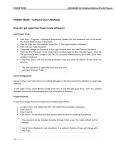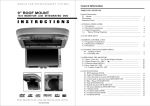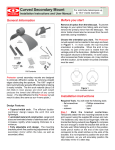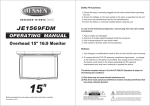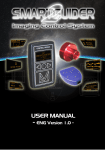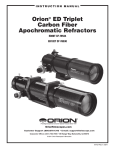Download Orion #5690 User's Manual
Transcript
INSTRUCTION MANUAL Orion LaserMate Deluxe ® ™ #5690 Newtonian reflectors perform at their best when their mirrors are accurately aligned. While it’s not difficult to do, collimation can be a chore if you do not have the proper tools. The Orion LaserMate Deluxe provides a clear, easy way to determine if your telescope’s mirrors need adjustment, and which adjustments need to be made. With the highly precise alignment provided by the LaserMate Deluxe, you’ll be enjoying better, crisper views in no time! The LaserMate Deluxe’s laser diode has been precisely aligned within it’s housing at the factory. Do not drop the LaserMate Deluxe or otherwise roughly handle it, or it may need to be returned for re-alignment. Re-alignment is a service that is not covered in the product’s limited warranty. Also, do not remove the label on the LaserMate Deluxe or otherwise attempt to make adjustments to the LaserMate Deluxe’s alignments screws; doing so will void the terms of the warranty. WARNING: The LaserMate Deluxe emits laser radiation, so it is important not to shine the beam into your or anyone’s eye. During the collimation procedure, it is also important to avoid direct reflections of the laser beam into your eye. Rather, look only at off-axis reflections to determine the position of the laser spot on the mirrors. It is safe to view the laser when it is reflected off a surface that will diffuse the light, such as the viewing screen of the LaserMate Deluxe. It is also safe to view the reflection off a mirror surface as long as the beam is not directed into your eye. Because of the potential danger from the laser beam, store your LaserMate Deluxe out of the reach of children. Marking the Primary Mirror To achieve best accuracy when collimating with the Orion LaserMate Deluxe, you will need to mark the center of the primary mirror with one of the supplied collimation targets. This will not affect the telescope’s performance. If you do not wish to mark your primary mirror, you will need to judge the primary mirror’s center by eye during the collimation procedure. While this is not recommended, it is possible to get adequate alignment of the optics without marking the primary mirror’s center. To accurately locate and mark the mirror’s center point, you will need to make a paper template. First, remove the primary mirror from your telescope. If you are unsure how to do this, consult your telescope’s instruction manual. If the primary mirror is glued into its cell, it is not necessary to remove it from the cell. Handle the mirror by its edges only, and be careful not to touch the surface with your fingers. Get a clean sheet of paper that is big enough to cover the entire mirror’s surface. For large diameter mirrors, you may need to tape several sheets of paper together. Lay the primary mirror on the paper and trace its outline with a pencil (Figure 1). Next, cut out the circle you have just traced with a pair of scissors. Fold the paper circle into quarters by folding the circle precisely in half, and then folding it in half again (Figure 2). Now, cut about 1/4 inch off the tip of the paper wedge you have created (Figure 3). Unfold the paper, and you will find that you have a paper template of your mirror with a hole Figure 1: Trace the outline at the center. of the mirror on the paper. Figure 2a, 2b: Fold the paper circle in half, and then in half again. Customer Support (800) 676-1343 E-mail: [email protected] Corporate Offices (831) 763-7000 Providing Exceptional Consumer Optical Products Since 1975 P.O. Box 1815, Santa Cruz, CA 95061 IN 218 Rev A 1100 Figure 3: Cut the tip off the paper wedge. Figure 4: Place the template on the mirror surface and carefully register its edge. Make sure the template is still clean; place the paper template over the surface of the primary mirror. Carefully register the template edge with the edge of the mirror (Figure 4). Now, take one of the supplied collimation targets and affix it to the center of the mirror’s surface through the hole of the paper template (Figure 5). The center of the primary mirror is now marked, and you can reinstall the primary mirror in the telescope (Figure 6). Note: For mirror cells that use mirror clips to secure the primary mirror in place, it is important not to overtighten the mirror clips. For Orion reflector telescopes, tighten the mirror clip anchor screws until just snug, and then back off each screw by 1/2 turn. Overtightened mirror clips will put stress on the primary mirror's figure, and will introduce astigmatism into the optical system as a result. Note About Centering the Secondary Mirror Under the Focuser Centering the secondary mirror under the focuser is an adjustment that can be made with the aid of the LaserMate Deluxe, but it requires marking the center of the secondary mirror in the same way the center of the primary mirror was marked. This is generally undesirable due to the large area of the supplied collimation targets compared to the total area of the secondary mirror. Since centering the secondary mirror under the focuser is an adjustment that very rarely, if ever, needs to be done, we recommend simply making this adjustment by eye. Again, refer to the collimation instructions in your telescope’s manual for the procedure on how to do this. If you wish to use the LaserMate Deluxe for centering the secondary mirror under the focuser, refer to the appendix section at the end of this manual. 2"-to-1.25" adapter Figure 7a, 7b: The LaserMate Deluxe fits directly into the drawtube of 1.25" focusers (left). If you have a 2" focuser, you will need to use an optional 2"-to-1.25" adapter (right). Adjusting the Tilt of the Secondary Mirror The first collimation adjustment made with the LaserMate Deluxe will be to adjust the tilt of the secondary mirror. Insert the LaserMate Deluxe into your telescope’s focuser drawtube (Figure 7). Secure it in place with the thumbscrew on the drawtube. Then turn the LaserMate Deluxe on by turning its thumbscrew clockwise. Figure 5: Affix the ring label to the mirror surface through the hole in the template. Figure 6: The primary mirror’s center is now marked, and it is ready to be reinstalled. Before You Begin Collimating Using the LaserMate Deluxe Accurate collimation of your telescope’s optics using the LaserMate Deluxe will most easily be achieved if you do a rough collimation of the optics with your eye first. This is because if the optics are grossly misaligned, it may be confusing to interpret which surfaces the laser is being reflected off of. Refer to your telescope’s instruction manual for the procedure on how to do a rough collimation with your eye. 2 Before looking into the optical tube, take a sheet of white paper and place it across the front aperture of the telescope. If you see a red laser spot on the sheet of paper, then your telescope is considerably out of collimation (Figure 8). Take note of the position of the red spot, and be careful not to place your eye in that position. Remember, it is safe to view the reflection of the laser beam off mirror surfaces as long as the beam is not directed into your eye. Red laser spot Figure 8: Place a piece of white paper in front of the open tube. If you see a laser spot on the paper, be careful not to place your eye in that position. Look down the front of the optical tube. Remember to keep your eyes clear of any direct reflections of the beam. Notice the red spot on the surface of the primary mirror itself; this is the laser beam being reflected from the secondary mirror off the surface of the primary mirror. The red spot should be centered on the primary mirror’s surface. If it isn’t, adjustments will be need to be made to the secondary mirror’s tilt (Figure 9). This is done with the secondary mirror collimation screws, usually located on the central hub of the telescope’s spider vane assembly. Laser spot on primary mirror Viewng screen Laser hole Figure 11: Once the laser spot is going back into the hole the laser beam originally came out of, the telescope is properly collimated. be hitting the inside wall of the telescope tube or the focuser drawtube. Make large adjustments to the collimation screws as needed to get the laser spot onto the viewing screen. Before After Figure 9a, 9b: To center the red laser spot on the primary mirror, you will need to adjust the tilt of the secondary mirror. Make adjustments to the telescope’s secondary mirror collimation screws until the reflection of the laser beam is centered on the primary mirror. If you have marked your primary mirror, then the red spot should fall directly in the center of the collimation target. Adjusting the Tilt of the Primary Mirror The final collimation adjustment is to adjust the tilt of the primary mirror. Make certain that the viewing screen on the collimator is facing the rear of the telescope. If it isn’t, loosen the securing thumbscrew on the focuser and rotate the LaserMate Deluxe until it’s viewing screen is clearly visible from the rear of the telescope. While standing at the rear of the telescope (where the primary mirror collimation screws are), look up at the viewing screen of the collimator. You should see the reflection of the laser somewhere on the viewing screen. If you do not see the reflection, then a large adjustments to the tilt of the primary mirror will be needed. Place a piece of paper in front of the open tube (as was done in Figure 8) and note the position of the laser on the paper. If the primary mirror is grossly misaligned, the laser spot may Laser point Viewing screen Hole Once the laser spot is on the viewing screen (Figure 10), you can perform the final collimation. Use the primary mirror collimation screws to move the laser spot until it is going back into the hole the laser beam originally came out of (Figure 11). Once this is done, you will see laser spot spray around the hole. You can make certain the laser spot is properly aimed into the hole by slightly adjusting one of the collimation screws to bring the laser spot out of the hole, then return it by turning the collimation screw in the opposite direction by the same amount. Collimation of the optical system is now complete. Go out and enjoy the view! The alignment of the mirrors should not need to be adjusted again unless the telescope is handled roughly. If you handle the telescope gently during transport, then only slight adjustments will need to be made to the mirrors. Use the LaserMate Deluxe before each observing session to check and make adjustments to the mirrors as needed. Care and Maintenance of Your LaserMate Deluxe Your LaserMate Deluxe is manufactured of the highest quality components and is carefully aligned and tested at the factory. Like all electronic equipment, it should be handled with care. If it is dropped or handled roughly, it may need to be returned to the factory for re-alignment. It should not be exposed to water, dust, heat or sunlight. To extend battery life store in a cool, dry environment. Installing New Batteries When the LaserMate Deluxe’s laser beam starts to dim or completely fades, it is necessary to install new batteries. To Top of Laser Mate Deluxe’s case Laser Mate Deluxe’s case Laser housing Top of laser housing Spring Batteries Figure 10: The laser spot has been reflected back to the viewing screen of the LaserMate Deluxe. The object now is to adjust the tilt of the mirror until the laser point is going back into the hole. Figure 12: To install new batteries, remove the top of the LaserMate Deluxe’s case and the top of the laser housing. 3 change batteries, you must unthread the top of the LaserMate Deluxe’s black aluminum case (Figure 12). This will expose the laser housing. Be careful not to lose the spring that goes between the top of the case and the laser housing. Do not attempt to remove the laser housing from the LaserMate Deluxe unit, or your collimator will need to be realigned at the factory. Also, removing the laser housing will void your factory warranty. It is necessary, however, to remove the top of the laser housing to access the battery compartment. Unthread the top of the laser housing. The battery compartment will now be exposed. If you have difficulty unthreading the top of the laser housing, slip a straightened paper clip or small rod through the hole in the top of the housing for extra leverage. Remove the spent batteries and install two fresh batteries. The batteries should be inserted so that the positive (+) end of the batteries face the open end of the battery compartment. After installing new batteries, replace the top of the laser housing, the spring, and the top of the LaserMate Deluxe’s case. Battery life is approximately three hours, so remember to keep the LaserMate Deluxe turned off when not in use to maximize battery life. Orion has sets of LR-44 batteries available, so call Orion Customer Service at 1-800-447-1001 or visit our website at www.telescope.com to order a new set. Appendix: Centering the Secondary Mirror Under the Focuser In order to use the LaserMate Deluxe to center the secondary mirror underneath the focuser, you must mark the center of the secondary mirror. Do this by first removing the secondary mirror from the telescope and making a paper template the same way you made a template for the primary mirror. Use the template and one of the remaining collimation targets to mark the secondary mirror’s center. Reinstall the secondary mirror once its center has been marked. Place the LaserMate Deluxe into the telescope’s focuser and turn it on. Now, peer into the optical tube and look at the primary mirror. Notice the reflection of the secondary mirror on the primary mirror; you will see a bright red spot on the secondary mirror where the laser beam is reflecting off it. The red spot should be exactly at the center of the collimation target on the secondary mirror. If it is not, you will need to make adjustments to the secondary mirror’s position until it is. For adjustments perpendicular to the optical axis, lengthen and shorten the spider vanes. For adjustments parallel to the optical axis, loosen or tighten the screw centered in the spider’s central hub. You may also need to adjust the rotation of the secondary mirror relative to the focuser. This product complies with 21 CFR 1040.10 and 1040.11 Specifications Laser power: less than 5mW Laser wavelength: 650nm Alignment: ± 3 arcmin One-Year Limited Warranty Focuser size: 1.25", fits 2" with optional 2"-to-1.25" adapter Case: aluminum, black anodized Dimensions: 5.875" long x 1.6" diameter Weight: 9.8 oz Batteries: LR-44, quantity 2 Battery life: approximately 3 hours Certification: meets all FDA regulations applicable at the time of manufacture The Orion LaserMate Collimator Deluxe is warranted against defects in materials or workmanship for a period of one year from the date of purchase. This warranty is for the benefit of the original retail purchaser only. During this warranty period Orion Telescopes & Binoculars will repair or replace, at Orion’s option, any warranted instrument that proves to be defective, provided it is returned postage paid to: Orion Warranty Repair, 89 Hangar Way, Watsonville, CA 95076. If the product is not registered, proof of purchase (such as a copy of the original invoice) is required. This warranty does not apply if, in Orion’s judgement, the instrument has been abused, mishandled, or modified, nor does it apply to normal wear and tear. In addition, the warranty is also void if the laser housing is removed from the unit, the product’s label is removed, or any other attempt is made to change the laser’s alignment. Factory realignment is a service not covered by this warranty. This warranty gives you specific legal rights, and you may also have other rights, which vary from state to state. For further warranty information, contact: Customer Service Department, Orion Telescopes & Binoculars, P.O. Box 1815, Santa Cruz, CA 95061; (800) 676 1343. Orion Telescopes & Binoculars Post Office Box 1815, Santa Cruz, CA 95061 Customer Support Help Line (800) 676-1343 • Day or Evening




